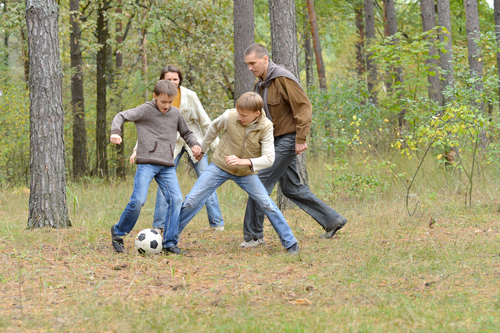 During the fall, many kids are involved with various sports including football, soccer, lacrosse and many more! Some adults will also engage in organized leagues or get involved in pick-up games such as kickball, softball or backyard football and soccer. While we encourage exercise and know that participating in these activities is very beneficial for ones health, we also want to make sure you are playing smart. Read below for some important tips on how to protect yourself from injury.
During the fall, many kids are involved with various sports including football, soccer, lacrosse and many more! Some adults will also engage in organized leagues or get involved in pick-up games such as kickball, softball or backyard football and soccer. While we encourage exercise and know that participating in these activities is very beneficial for ones health, we also want to make sure you are playing smart. Read below for some important tips on how to protect yourself from injury.
Exercise is an important part of a healthy lifestyle, and sports are one approach many people choose to use to get their exercise.
- For people with back pain, sports can still be a viable option if they pay attention to their back.
- For others who participate in sports, knowing the type of strain various sports place on the back may help prevent a back injury.
This article gives specific information about sports injuries and back pain from bicycling, weight lifting, running, swimming, skiing, golf, and tennis.
Types of Sports-Related Back Injuries
When participating in any sport, injuries to any part of the spine are possible, as well as injuries to the soft tissue and fascia that help comprise the makeup of the body. Up to 20% of all injuries that occur in sports involve an injury to the lower back or neck.
Lower Back Injury
The lower back is subject to a great deal of strain in many sports. Sports that use repetitive impact (e.g., running), a twisting motion (e.g. golf), or weight loading at the end of a range-of-motion (e.g., weightlifting) commonly cause damage to the lower back.
Neck Injury
The neck is most commonly injured in sports that involve contact (e.g., football), which place the cervical spine (neck) at risk of injury.
Upper Back Injury
The thoracic spine (mid portion of the spine at the level of the rib cage) is less likely to be injured because it is relatively immobile and has extra support. Injuries seen here can involve rib fracture and intercostal neuralgia as well as intercostal muscle strains in sports that involve rotation of the torso (e.g. weight training with rotation), swimming, golf, tennis, and even skiing.
Exercise is an important part of a healthy lifestyle, and sports are one approach many people choose to use to get their exercise.
- For people with back pain, sports can still be a viable option if they pay attention to their back.
- For others who participate in sports, knowing the type of strain various sports place on the back may help prevent a back injury.
Stretching and Warm-Up Prior to Exercise
While static stretching prior to any type of exercise used to be recommended, a number of studies in recent years have shown that stretching the muscles prior to exercise is not needed. A number of studies have shown that it does not help prevent injury, and likely does no harm either.
For every sport, a thorough warm-up should be completed before starting to play. The warm-up will target the muscles used in that sport, but it should also prepare the back for the stresses to come.
Exercise is an important part of a healthy lifestyle, and sports are one approach many people choose to use to get their exercise.
- For people with back pain, sports can still be a viable option if they pay attention to their back.
- For others who participate in sports, knowing the type of strain various sports place on the back may help prevent a back injury.
This article was originally posted on spine-health.com.







